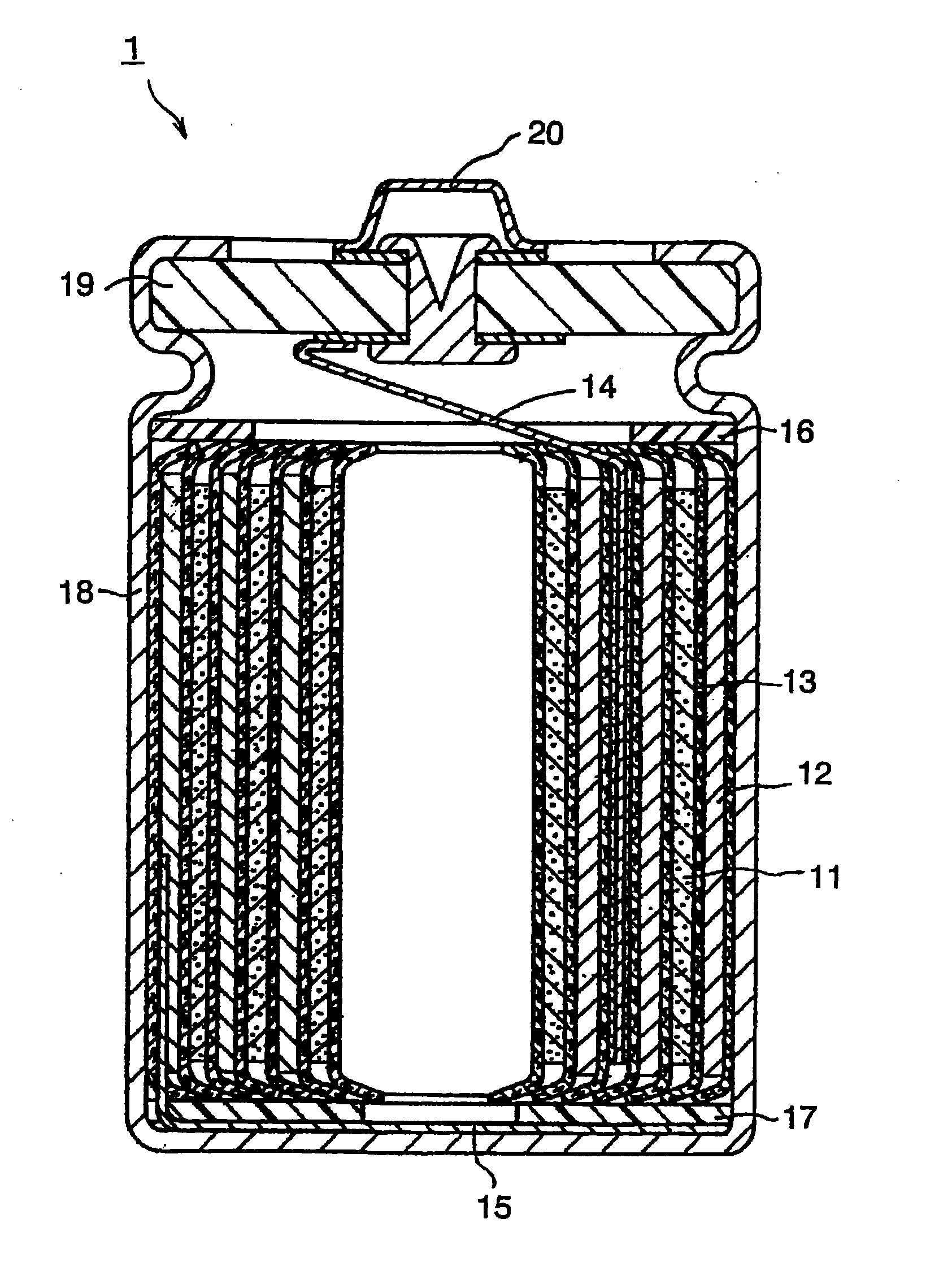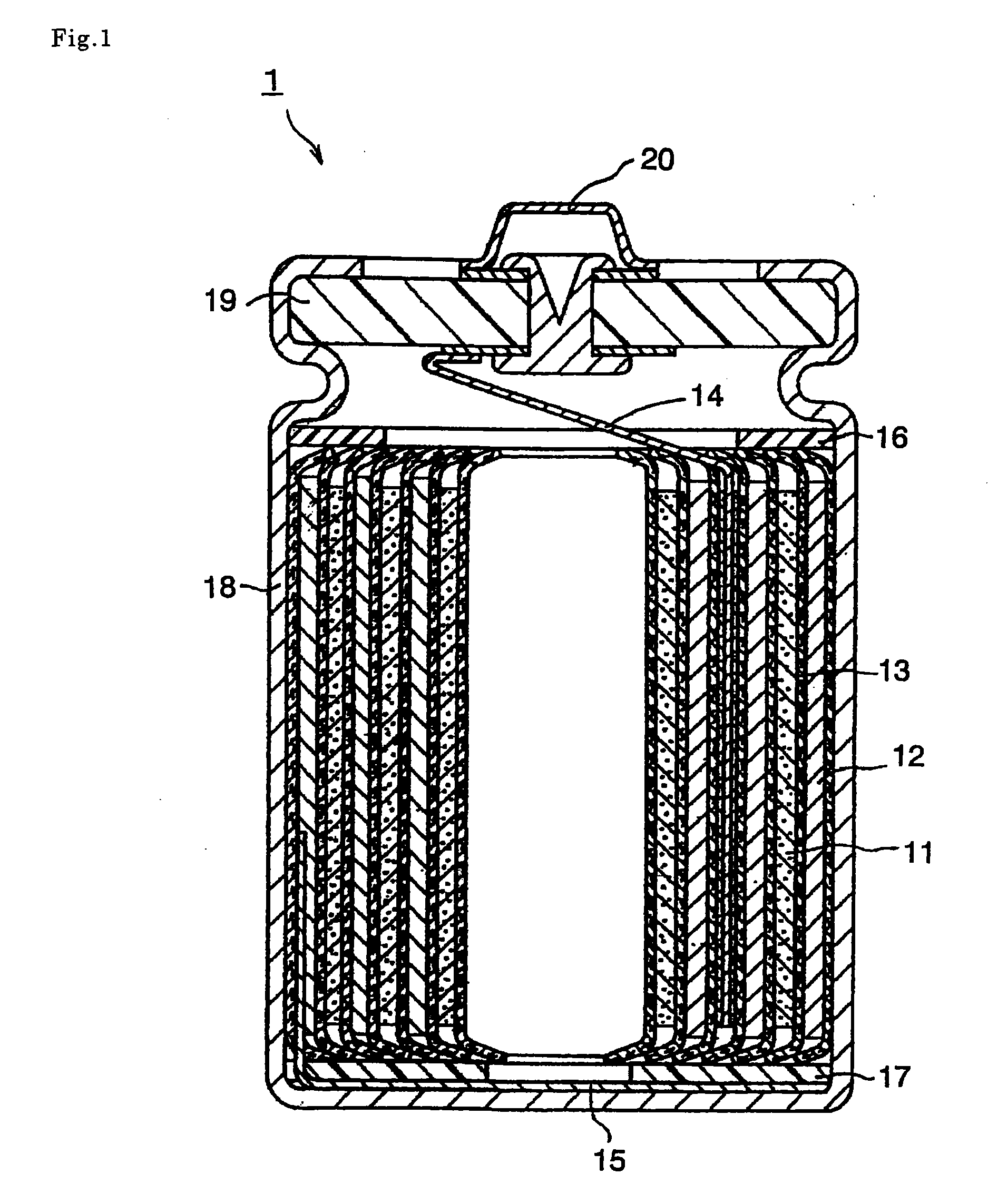Non-aqueous electrolyte and non-aqueous electrolyte secondary battery
a secondary battery, non-aqueous electrolyte technology, applied in the direction of non-aqueous electrolyte cells, cell components, electrochemical generators, etc., can solve the problems of difficult use of solvent mixtures of ec and pc in non-aqueous electrolyte secondary batteries, and achieve superior cycle characteristics and load characteristics, and favorable medium for charge and discharge reactions. , the effect of superior wettability
- Summary
- Abstract
- Description
- Claims
- Application Information
AI Technical Summary
Benefits of technology
Problems solved by technology
Method used
Image
Examples
example 1
Preparation of Single-Phase Non-Aqueous Electrolyte and Evaluation of Separator Wettability
[0065]A solvent mixture of EC, PC and the fluorine-substituted ether represented by the following Formula (i) was used as a non-aqueous solvent. As a lithium salt, LiPF6 was used.
CF3CFHCF2CH(CH3)OCF2CFHCF3 (i)
[0066]First, solvent mixtures were prepared by mixing EC and PC at ratios of 3:1, 2:2 and 1:3 (molar ratio) as shown in Table 1, and adding the fluorine-substituted ether (i) in an amount of 0.1 to 10 mol % relative to the whole amount of the obtained solvent mixture. The obtained solvent mixtures were all single-phase solutions.
[0067]Next, non-aqueous electrolytes of the present invention were prepared by dissolving 1 mol (151.9 g) of LiPF6 in 1 liter of the solvent mixture. As can be seen from Table 1, when the amount of fluorine-substituted ether (i) was 10 mol %, and the molar ratio of EC and PC was 3:1 and 2:2, the resulting solutions separated into two phases. On the other hand, w...
example 2
Assembly of Non-Aqueous Electrolyte Secondary Battery and Evaluation of Load Characteristics
(1) Preparation of Non-Aqueous Electrolyte
[0070]In the same manner as in EXAMPLE 1, non-aqueous electrolytes were prepared by mixing EC, PC and the fluorine-substituted ether represented by the above Formula (i) and dissolving 1 mol of LiPF6 in 1 liter of the obtained solvent mixture. In Table 2, the value obtained by subtracting the mol % value of the fluorine-substituted ether (i) from 100 is the mol % value of the solvent mixture of EC and PC, and the ratios (molar ratios) at which EC and PC were mixed were as shown in Table 2.
(2) Production of Positive Electrode
[0071]A slurry of a positive electrode material mixture was prepared by mixing 93 parts by weight of LiNi0.8Co0.13Al0.07O2 powder (positive electrode active material), 3 parts by weight of acetylene black (conductive material) and 4 parts by weight of polyvinylidene fluoride (binder), and dispersing the resulting mixture in dehydra...
example 4
Influence of Negative Electrode Active Material on Cycle Characteristics
(1) Preparation of Non-Aqueous Electrolyte
[0086]A solvent mixture was obtained by mixing EC, PC and the fluorine-substituted ether (i) at a ratio (mol %) shown in Table 4. Then, a non-aqueous electrolyte was prepared by dissolving 1 mol of LiPF6 in 1 liter of the obtained solvent mixture.
(2) Production of Positive Electrode
[0087]A positive electrode sheet containing LiNi0.8Co0.13Al0.07O2 as a positive electrode active material was produced in the same manner as in EXAMPLE 2. The obtained positive electrode sheet was cut into a 35 mm×35 mm piece, and the resulting piece was welded to an aluminum plate equipped with a lead by ultrasonic welding to produce a positive electrode.
(3) Production of Negative Electrode
[0088]A slurry of a negative electrode material mixture was prepared by mixing 98 parts by weight of artificial graphite powder (negative electrode active material), 1 part by weight of modified styrene-but...
PUM
| Property | Measurement | Unit |
|---|---|---|
| output voltage | aaaaa | aaaaa |
| thickness | aaaaa | aaaaa |
| thickness | aaaaa | aaaaa |
Abstract
Description
Claims
Application Information
 Login to View More
Login to View More - R&D
- Intellectual Property
- Life Sciences
- Materials
- Tech Scout
- Unparalleled Data Quality
- Higher Quality Content
- 60% Fewer Hallucinations
Browse by: Latest US Patents, China's latest patents, Technical Efficacy Thesaurus, Application Domain, Technology Topic, Popular Technical Reports.
© 2025 PatSnap. All rights reserved.Legal|Privacy policy|Modern Slavery Act Transparency Statement|Sitemap|About US| Contact US: help@patsnap.com


